July
1st, 2007:
Ever wonder about the work crews with
the orange vests? They are members of the Santa Barbara County Sheriff's
Work Alternative Program (SWAP): 
"Convicted misdemeanants with
60 days or less to serve may apply to this program as an alternative to
jail. The program involves assignment to one of several work sites throughout
the County. Participants may serve their sentences in increments, such
as weekends, so as not to affect their full-time jobs. Participants also
pay a daily fee to offset the cost of the program." SBSO
online
One way that the County stretches its limited budget is through
the liberal use of what used to be called convict labor.
But whatever you call it, here at Goleta it is highly appreciated.
Especially when their efforts are directed, as they were yesterday, towards
scrubbing down the pier decking or last month when they hammered down all
protruding nailheads on the pier.
July
9th, 2007:
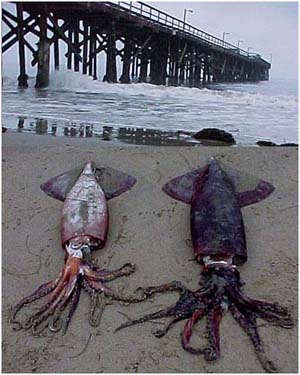 They're
here and they are huge! Humboldt
Squid were found all up and down the beach this morning after drifting
in with the high tide overnight.
They're
here and they are huge! Humboldt
Squid were found all up and down the beach this morning after drifting
in with the high tide overnight.
No explanation yet for their appearance here on our beach other
than the fact that offshore anglers have been catching them in the Santa
Barbara channel for several weeks now.
Previous
strandings have been thought due to neurological
damage "... from eating fish and krill which feed on algal blooms.
The blooms produce harmful acids that get concentrated up the food chain."
The pair pictured were no longer alive but did not show any obvious
signs of trauma such as teeth marks or missing body parts.
In April a sperm whale was found beached off of Isla Vista.
Due to a large collection of squid beaks found in its stomach it also was
thought to be a victim of local domoic acid poisoning.
On the other hand maybe it's just a case of some anglers dumping
a portion of their catch after realizing that they had no place to store
an extra couple hundred pounds of calamari! After having been treated
to a Humboldt Squid dinner myself last week I can see why one would be
tempted to keep more than one had room for ...
 After
photographing the squid this morning I noticed a young sea lion underneath
the pier entangled in a sabiki rig which is a multiple hook jig line used
by mackerel and live bait fisherman.
After
photographing the squid this morning I noticed a young sea lion underneath
the pier entangled in a sabiki rig which is a multiple hook jig line used
by mackerel and live bait fisherman.
This particular animal has been observed several times over the
past week but this was the first time that it was actually out of the water
and so could be captured.
I called the Santa Barbara Marine
Mammal Center (805 687-3255) and enlisted the help of several regulars
to keep sight-seers from approaching it and scaring it back into the water.
A little while later Peter
Howorth from the Center arrived with his large net and transport cage.
Peter first immobilized the pup by rolling it in the net. Then, with the
help of several bystanders, the secured animal was brought up from the
beach to the parking lot where it was 'unrolled' directly into the cage
for transport to the Center for treatment.
July
11th, 2007: Spoke
with Shane Anderson, UCSB's marine specimen collector,
as he prepared to launch one of the University's boats this morning from
the pier. He said that the squid had been tested for domoic acid
poisoning previously with negative results and so
he didn't feel that was the explanation this time either.
He said that the current batch had been
feeding heavily on grunion which is not an offshore species and several
squid had actually been found alive on the beach. I got the impression
he was suggesting that perhaps the squid had become stranded chasing the
grunion ashore. Not typical behavior for such a deepwater species ... wonder
what's behind it.
Incidentally I discovered that Shane and
his wife Genny, both marine biologists, are also accomplished artists ...
in this case gyotaku or fish printing. A collection of their exhibited
work also includes a series of photographs documenting the process
used to create an image from a great white shark.
July
13th, 2007:
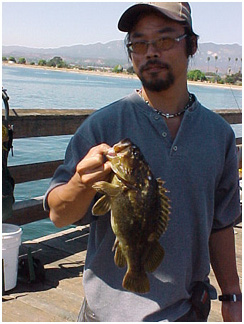
Gone Fishin'
(July 13, 2004)
"I should think there is nothing very bad
about dying expect for the people one has
to leave and the things one hasn't had time
to do. When the time comes, if I know what
it's all about, I suppose I shall think, among
other things, of the fish I haven't caught and
the places I haven't fished."
Roderick Haig-Brown, angler and author:
A River Never Sleeps (1946).
July
20th, 2007: Over the past several weeks
there have been at least four Black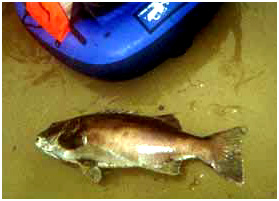 Sea Bass caught in the Park ... two off the pier and two more off the shore.
Sea Bass caught in the Park ... two off the pier and two more off the shore.
I'm happy to say that all four were released in accordance with
the Department of Fish and Game's 'clean
release' recommendations.
Black or Giant
Sea Bass (Stereolepis gigas)were a mainstay of California's commercial
and recreational anglers until 1982 when the Leglislature afforded it Protected
Species status to conserve the dwindling stocks.
Their natural environment is the deep rocky areas off the coast
but during their spawning season (Summer and Fall) they can be found in
shallower waters. Over the years a number have been caught from local piers.
There is hope that these fish are beginning to reestablish their populations
and perhaps their status will be upgraded sometime in the future.
Interestingly the largest ever caught off a pier was from Stearns
Wharf four months after the big quake that leveled the city:
GIANT SEA BASS LANDED AFTER LONG BATTLE
Biggest Fish of the Year
R. A. Hendricks brought in the biggest fish of the year late yesterday
afternoon, when he landed a 453-pound black sea bass at Stearns Wharf after
a hard fight that lasted nearly two hours. He was fishing on the side of
the wharf opposite the pile driver when the big fish struck. He played
the fish from the wharf until he had broken one of the handles on his reel
and was nearly exhausted. He said this morning that the fish made forty
to fifty runs out to the end of his 150 yards of line. Each time
the fish apparently tired and allowed himself to be towed back to the wharf
by the fisherman. Finally Mr. Hendricks jumped into a row boat that was
alongside the wharf. The fish was tied to the boat and the fight continued.
Several times the big fish was worked in alongside of the boat, but would
suddenly break away for another run. A small .22- caliber rifle was brought
into play as the fish came alongside of the boat for the final time and
five shots stopped the fight. The fish was hauled up the stairs to the
wharf and then brought to J. L. Hendricks' store on Estado. [*] Many Santa
Barbara fishermen saw the huge fish this morning. It measured seven feet
three inches from tip to tip and two feet across the tail.
Santa Barbara Daily News October 23, 1925
* Following the earthquake the town was rebuilt in the then popular
Spanish Revival style and the main street, State Street, was renamed Estado.
It has since reverted to its original spelling.
July
26th, 2007:
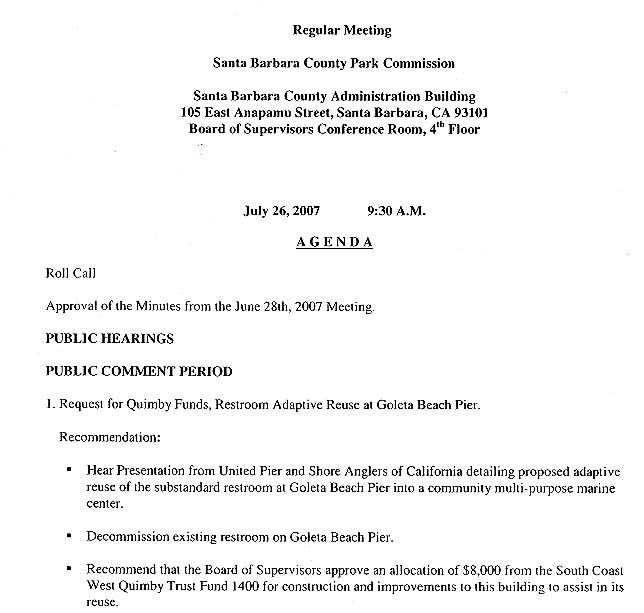
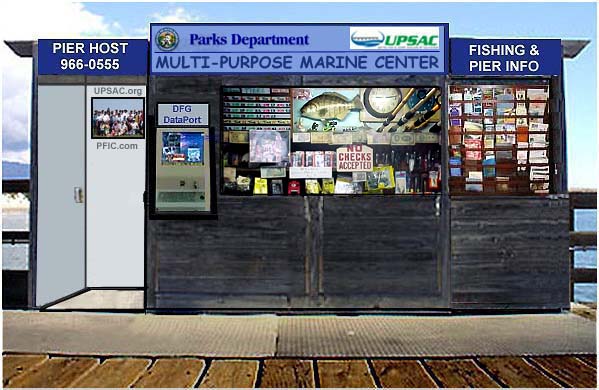
What is the UPSAC proposal?
United Pier and Shore Anglers of California is requesting a decommissioning
of the existing mid-pier bathroom at Goleta Beach County Park. We
are proposing in its place a community multi-purpose marine center.
Acquiring this location would allow for the completion of UPSAC's Model
Pier Demonstration Project which was initiated at Goleta last summer.
Our preference would be for an annual renewable contract in exchange for
a minimum of 2 hours daily pier cleanup by UPSAC staff. .
What services does UPSAC plan
to provide?
a. Angler education and support:
Stock and distribute the annual California Dept. of Fish and Game (DFG)
Sportfishing Regulations booklets.
Stock and place DFG fish 'rulers' (guides to legal size limits) at
multiple locations on the pier.
Provide fish identification service and official weigh-in and certification
as needed.
Create and distribute (free) pier maps showing the various species and
their locations as well as selected angling tips.
Angling clinics emphasizing pier etiquette and ethical angling practices.
Provide an external, wall mounted time, tide and temperature display.
b. Angler impact mitigation:
Promote the use of existing environmentally sensitive fishing tackle and
gear (e.g. circle hooks, non lead weights etc.) and partner
with tackle manufactures as a test bed for newly developed products.
Establish an active Do Not Feed Wildlife campaign including additional
signage, posters, handouts and personal contact to reduce the number
of birds attracted to the pier. By controlling food sources there
will be fewer birds on the pier and thus fewer accidental snaggings.
Remove discarded fishing line, hooks, sinkers and unused bait from the
topside of the pier on a daily basis.
Sponsor annual underwater cleanups by local dive clubs.
Provide courtesy bait boards (to protect railings and benches) and
bait rags (to hide bait from birds).
Maintain existing monofilament recycling baskets on pier and provide replacements
as needed.
c. Community outreach:
Seek grants and other funding for additional educational and environmental
displays on the pier similar to Ventura's Pier
Into the Future project.
Mount and maintain a Community Bulletin Board/Calendar on the outside of
the building announcing fishing clinics, walking tours, bird watching
events and other items of interest to pier visitors.
Maintain the current Goleta Pier web
site and update it with links to all environmental and
special interest groups having projects relating to Goleta Pier and Slough.
Liaison with UCSB's Marine Sciences Department and other community groups
to develop and host joint projects and educational presentations.
Work with local teachers and environmental groups to develop and
host specialized educational presentations at the pier for students after
school and during the summer.
Provide sponsorship for the fishing clubs in local schools.
d. Pier maintenance and security:
The UPSAC staffer at the Center will be identified as a Pier Host similar
to the camp host position within the State and County Park system.
The intent is to monitor and mentor transactions at the pier to insure
a safe, pleasant, and hopefully educational experience.
The Host will also be responsible for the daily pier cleaning,
discarded tackle removal and assisting with injured birds and other marine
wildlife problems. A list of emergency numbers and after hours contacts
will be posted on the exterior wall.
The Center would become the central point of contact for all visitors
to the pier ... a place where the general public and anglers in particular
could learn more about the local marine environment and the necessity
of and techniques for minimizing our impact.
What would be the Center's hours?
During the school year the Center would be staffed on weekends,
holidays and during scheduled events only. From June through
September the Center would be open six days per week (closed Thursdays).
The hours will be 10am - 5pm. The current Pier Host will staff
it initially until there are trained backups.
Background Information:
Project director - Ken Jones ken.jones@upsac.org (209
367-5961)
Project manager - Boyd Grant (Pier Host - Goleta) boyd.grant@upsac.org
(805 637-6708)
Associated web sites:
Goleta Pier Log
United Pier & Shore Anglers of California
(educational non-profit 501K)
Pier Fishing in California
(owner-Ken Jones)
UPSAC Gants and Projects:
Bolsa
Chica Fishing Tutorial
Pepper
Park Pier Fishing Derby
Monofilament
recycling baskets
Ethical
Angling classes
Underwater
cleanups
References:
Milton Love, Research
Biologist, Marine Science Institute, University of California, Santa
Barbara
Edgar W. Roberts III, Associate Marine Biologist, Recreational Fisheries
Data Project, California Department of Fish and Game
Carolyn (Carrie) Culver, Santa Barbara/Ventura County Advisor
Sea Grant Extension Program
Marty Golden, National Oceanic and Atmospheric Administration, Pacific
Coast Recreational Fisheries Coordinator
The proposal was accepted!
At the meeting initially there were objections
to the complete removal of existing bathrooms which were resolved when
the County agreed to provide two Porta-Potties, one mid-pier and one at
the end. The mid-pier (hoist area) unit will be a full disabled access
facility. These will be single person units thus discouraging loitering
inside which had been a problem.
I want to thank the head ranger at Goleta
Beach County Park, Larry Austin, for his foresight in suggesting the possiblity
of an adaptive reuse of the substandard pier bathrooms and for all of the
encouragement and assistance he provided in our initial and subsequent
discussions.
It is my hope that this center will become
a true community asset over the years and will be a source of inspiration
for pier lovers everywhere.
Questions or comments? ... email Pierhead
Copyright © 2007 by Boyd Grant. All Rights Reserved